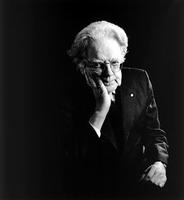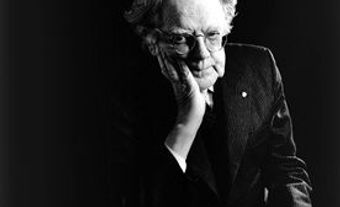Essay in English
An essay is a brief, discursive piece of prose which develops a single theme from a personal point of view, following the prototype established by French essayist Michel de Montaigne (1533-92). The earliest Canadian resemblance to this form emerged during the 19th century in the Maritimes, where the primary intention of writers such as Joseph HOWE and George Stewart was usually descriptive or hortatory. JOURNALISM has always provided the greatest stimulus to the essay in Canada. In The Week (Toronto, 1883-96) appeared articles discussing current political or religious questions. Those by Goldwin SMITH or his private secretary Theodore A. Haultain have less in common with the traditional form than the unpretentious and intimate "Saunterings" of Sara Jeannette DUNCAN.
Yet the only contributor who really deserves the title "essayist" is Archibald MacMechan. His collections, The Porter of Bagdad, and Other Fantasies (1901) and The Life of a Little College, and Other Papers (1914), contain whimsical reveries that recreate an innocent era of nature and art reminiscent of essays by Victorian writers John Ruskin and Matthew Arnold, whom he admired.
Early Influences
Physician Sir William OSLER, concerned that his medical students might miss "those gentler influences which make life worth living," enunciated in Aequanimitas (1903) the need to harmonize the humanities and sciences. Bliss CARMAN's The Kinship of Nature (1904) treats his recurring didactic theme of self-betterment and personal harmony. Sir Andrew MACPHAIL, a medical professor at McGill University and editor of THE UNIVERSITY MAGAZINE, published Essays in Puritanism (1905), Essays in Politics (1909) and Essays in Fallacy (1910), which are distinguished by their pungency and winsome vigour. Of less literary interest are the moralizing articles of journalist Thomas O'Hagan, which originally appeared in the Catholic Register and were published as Chats by the Fireside (1911).
In Pastures Green (1915), The Red Cow and her Friends (1919) and Around Home (1925) are collections of another journalist, Peter McArthur, from his farm column in the Toronto Globe. His humorous and often rambling depiction of Ontario pastoral life reflects the freshness and earthiness of the countryside. The simple natural settings were also celebrated by Toronto lawyer William Hume Blake, who describes angling in the Laurentians in Brown Waters, and Other Sketches (1915) and A Fisherman's Creed (1923).
Essays and Literary Studies (1916) by Stephen LEACOCK, although primarily humorous, sometimes presents serious themes. His satiric pieces reflect the advance made by the essay form in Canada since its early didactic and descriptive precursors. The Canadian Forum (founded 1920) encouraged the journalistic essay. Perhaps its most eloquent contributor was scholar Douglas Bush, who displayed a gift for phrasing and allusion, along with a genial irreverence for some of his colleagues' preoccupation with a national literature and identity. W.D. Woodhead and John D. Robins wrote with more overt humour. The essays of other contributors such as Barker FAIRLEY, Margaret Fairley, John Macnaughton, Frederick Philip GROVE, E.K. Broadus, B.K. SANDWELL, Frank UNDERHILL and A.J.M. SMITH treated art, the humanities, criticism, contemporary poetry, education and socialist politics with an academic rather than a familiar tone.
That the critical spirit continued to dominate the form is indicated in the title of Malcolm ROSS's anthology covering much of this period, Our Sense of Identity (1954). William Arthur DEACON, for example, moved from the whimsy and humour of Pens and Pirates (1923) to the critical My Vision of Canada (1933). Lucid and scholarly essays on people, books and ideas were also being published by Maurice Hutton, John Charles Robertson and Gilbert Norwood, professors at the University of Toronto. Less detached and contemplative are the collections of newspaper feature writers, yet many of these in their use of description, anecdote, reminiscence and humour approach the timeless quality of the essay. Noteworthy among them are One Thing After Another (1948) by C.B. Pyper and From Our Town (1959) by Jack Scott. The most widely read columnists were the humorists. The sketches of Peter Donovan from Saturday Night were collected in Imperfectly Proper (1920). Newton MacTavish of Canadian Magazine published Thrown In (1923), recollections of a rural childhood which are amplified in Newton MacTavish's Canada (posth 1965). In 1959 The Best of Gregory Clark was culled from his anecdotes in Weekend Magazine. Eric NICOL has recorded refreshingly satirical anecdotes, some of which were collected from columns in the Vancouver Province, in illustrated books including The Roving I (1950) and Canada Cancelled Because of Lack of Interest (1977). Common sense, tolerance and gentle amusement at human foibles permeate the style of these journalists.
Significant Themes
A significant journalistic theme of the period was the return to nature. Cecil Francis Lloyd describes its attraction in Sunlight and Shadow (1928). His Malvern Essays (1930), modelled after Montaigne's, express a wistful if weary acceptance of "The Burden of Existence." More in the tradition of American writer Henry David Thoreau were Harry Lutz Symons in Friendship (1943) and Canadian Forum contributors and academics E.K. Broadus (Saturday and Sunday, 1935) and John D. Robins (The Incomplete Anglers, 1943). Roderick HAIG-BROWN, a fisherman in the Waltonian tradition, describes outdoor delights and their value for the individual in A River Never Sleeps (1946) and Measure of the Year (1950). His Fisherman's Spring (1951), Fisherman's Winter (1954) and Fisherman's Summer (1959) as well as his posthumous Writings and Reflections (1982) provide a pattern of civilized life. Kenneth McNeil Wells collected into 4 books a series of articles from the Toronto Telegram chronicling life at The Owl Pen (1947) farm, which was Up Medonte Way (1951), and was successful in transcribing Ontario rustic idiom.
Various writers used the essay to increase the awareness or appreciation of the "average reader." B.K. SANDWELL, editor of Saturday Night, employs Swiftian irony in The Privacity Agent and Other Modest Proposals (1928) to contrast the 20th century with happier past eras. F.P. Grove in Over Prairie Trails (1922) describes natural scenery with cosmic implications, tracing changing moods and emotions during 7 journeys over one Manitoba road. His The Turn of the Year (1923) is more forbidding and less personal. Morley CALLAGHAN, in monthly commentaries for New World magazine (1940-48) and pieces in Saturday Night, Maclean's and other journals, dealt with topical themes from an imaginative point of view. In Cross-Country (1949) Hugh MACLENNAN treats the Canadian character in a cultivated style marked by personal memories and biases. His Thirty and Three (1954), Scotchman's Return (1960) and The Other Side of Hugh MacLennan (1978]) attempt to define and reconcile transition with the world around him.
Novelist, dramatist and editor Robertson DAVIES ignores the "average reader" as being incapable of understanding "good talk." In Diary (1947) and Table Talk (1949) are portrayed the tastes and opinions of the fictional Samuel Marchbanks, who like Dr Samuel Johnson "loved tea, conversation and pretty women, and had not much patience with fools." A Voice from the Attic (1960) pursues the theme that reading as a private, individual art is the mark of the cultivated mind and the central activity of the good life; and Samuel Marchbanks' Almanack (1967) continues Davies's examination of Canadian society. Somewhat different are the essays of arctic explorer Vilhjalmur STEFANSSON. The logical and even philosophical structure of his pieces in Adventures in Error (1936) conceals an ironical exploration of man's mental processes which affirms that "errors" of the human imagination are true and that human desires, even when self-deceptive, are important.
Northrop FRYE has maintained the tradition of the scholarly essayists in volumes such as The Educated Imagination (1963), The Modern Century (1967), The Bush Garden (1971) and Spiritus mundi (1976). He provocatively explores literature, education and other aspects of contemporary society. George WOODCOCK, a less academic but wider ranging "man of letters," displays an easy competence in the essay form in such books as The World of Canadian Writing (1980). Eli MANDEL's A Passion for Identity: An Introduction to Canadian Studies (1987) expands on his earlier Contexts of Criticism (1971). In a similar vein is David Staines's The Canadian Imagination: Dimensions of A Canadian Culture (1977). Established writers of fiction have always found the genre challenging. In Hunting Tigers Under Glass (1968), Shovelling Trouble (1972) and The Great Comic Book Heroes (1978), Mordecai RICHLER expatiates on such themes as the Jewish experience, "Why I write" and the changing national scene. Hugh HOOD, in The Governor's Bridge Is Closed (1973), expresses his cheerful belief in Canadian life and culture. Margaret LAURENCE's Heart of a Stranger (1976) and Margaret ATWOOD's Second Words (1982) are collections of personal pieces which, like Gabrielle ROY's The Fragile Lights of Earth (1982), provide perceptive insights into the writer's world and social history.
Running to Paradise (1962) by Kildare Dobbs (although largely autobiographical reminiscence), Reading the Time (1968) and Pride and Fall (1981) are marked by a versatile style befitting the wide range of topics treated. Norman WARD in Mice in the Beer (1960) and The Fully Processed Cheese (1964) displays an attitude of tolerance and amusement toward topical themes and toward his academic colleagues. The posthumous collection of contributions by Ralph ALLEN to the Toronto Star and Maclean's are entitled The Man from Oxbow (1967). Crisis at the Victory Burlesk (1968) is a collecton of Robert FULFORD's early journalism, which is less reflective than his regular essays in Saturday Night. The waspish miscellanies of Richard Needham, originally published in the Globe and Mail, have appeared in several collections, including Needham's Inferno (1966) and The Wit & Wisdom of Richard Needham (1977). Columnist Allan FOTHERINGHAM has collected a number of his acerbic, irreverent political essays in Malice in Blunderland (1982). Another exemplar of persona journalism is Harry Bruce, whose collection of Toronto Star columns, The Short Happy Walks of Max MacPherson (1968), combines history and description.
Neurosurgeon Wilder PENFIELD, emulating his mentor Osler, in The Second Career (1964) and Second Thoughts (1970) reflects on the need for "eternal vigilance and resolute action" in a changing world. Economist John Kenneth GALBRAITH gives an ironic and acerbic account of his boyhood in The Scotch (1964), and presents the viewpoint of a perceptive and versatile diplomat in A Contemporary Guide to Economics, Peace, and Laughter (1971). Others who write in a discursive fashion about their special interests include George GRANT (philosophy), John BECKWITH (music) and Greg CURNOE (art).
Folksy and nostalgic memories of rural simplicity form H. Gordon Green's central theme in a number of books, including A Time to Pass Over (1962) and With My Sock Feet on the Oven Door (1975). Harry J. BOYLE exploits the same vein, beginning with Mostly in Clover (1961) and continuing through Memories of a Catholic Boyhood (1973). Another variation of the pastoral mode is The Battle of Mole Run and Other Offenses (1967) by Howard T. Mitchell. A more enduring presentation of farm life is Western Windows (1967) by Bruce HUTCHISON. In The Far Side of the Street (1976) his informal essays cover 50 years of change in Canadian life.
In The Medium is the Message (1967), Marshall MCLUHAN developed a type of essai concret, involving a mosaic of verbal and visual, spatial and durational material, in what he called a "collide-oscope of interface situations" without linear sequence. His unique technique has been assimilated rather than imitated by other writers.
During the second half of the 20th century, the Canadian essay continues to be influenced chiefly by journalism, although television's slickness has made it difficult for the columnist to maintain freshness. The increased tempo and pragmatic urgency of technological life have militated against undogmatic attention to theme and easy discursiveness, which survive mainly in reminiscences of more relaxed eras.
See also SHORT FICTION.

 Share on Facebook
Share on Facebook Share on X
Share on X Share by Email
Share by Email Share on Google Classroom
Share on Google Classroom




